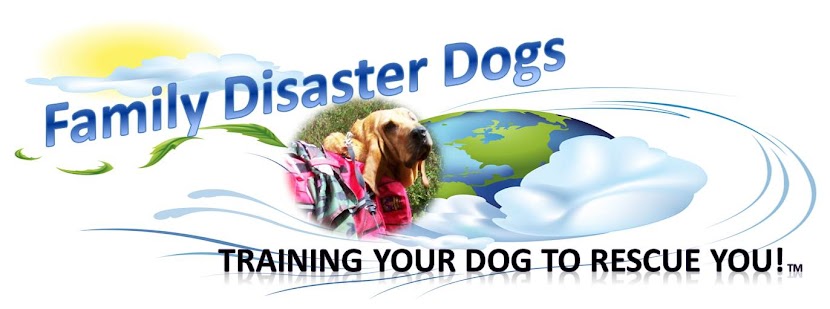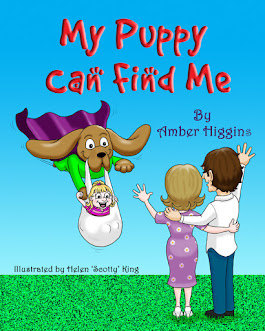This lesson for the Family Disaster Dog is where the fun begins.
Every dog can easily learn this lesson in finding a person indoors. This lesson becomes useful in the event of a building collapse or if a person is hiding from fear which can happen when people get lost or disoriented from lack of food,water or being rescued. When people are afraid or injured they often hide, children who become lost often hide waiting for parents to find them so this lesson can come in handy if a person becomes lost or if a building collapses.
In the event of an earthquake,flood or natural disaster do take caution when working on unstable surfaces. Always allow your dog to choose their own way through rubble or debris because they know what they are capable of more then we do and we might lead the dog into a dangerous area because they are following orders.
If a dog refuses to go on a surface after they are trained then back off of that surface and find another way into the area, ask the dog to lead you to the safest way and follow the dog. Dogs are much more sure footed then us and they use instincts we know nothing about but in an emergency we can use these instincts to our advantage by following the dog.
This indoor lesson can be practiced anytime in your home by playing with your dog and another family member or friend. You can use more then one person in this lesson unlike in the tracking lessons. This lesson can be done with all the children in the house at once because all you will be doing is playing hide and seek with your dog.
To Begin
First choose a word to use to tell your dog to do an Area Search, such as "seek" or "search" or "find". Use a different word for a command then what you used to do the tracking or trailing lessons with your dog.
Once you know your word then always use this word with your dog's name to tell them to search.
You can sit or stand where you are comfortable in your house, even while watching TV on the sofa and call your dog to you then have one of your children go and hide from the dog while your dog watches them leave.
Once the person is hidden then release the dog and follow them to search for the person.
At first make sure your dog sees the person leave to make the dog interested in following them by having the child call the dog or wave to the dog and run to hide. Just like hide and seek , count to so many counts (10,20) thus giving the person time to hide then release your dog asking the dog to "Seek" or "Find".
After a week or two of playing this game and lots of praise, treats are fine from the person hiding then the dog will find or seek out people hiding whenever you ask them to look in the room or space.
Once the dog is finding the person who the dog can see leave then you can put the dog in another room where they do not see the people leave then bring your dog in and ask them to seek or find. You can have people hide while the dog sleeps or is outside then ask your dog to find them and give praise when the dog shows any interest to encourage the dog to do this for you. Praise when they make the find.
Tips
At first, you should follow your dog to the hiding person so you can praise the dog and in later lessons you can sit still and let your dog bring the person back to you which will help to teach your dog to come back to you if the person is found away from you and trapped.
Always praise the dog as they go in the right direction and make a find of the person or evidence from a person, coat,hat,tissue paper.
The dog can learn to find the person and then return to you to get you to show you where the person is trapped by having the person tell the dog to go get you and then you calling the dog back to you. This recall lesson will be discussed in length in future lessons.
You can also follow your dog and move room to room waving your hand to teach your dog a hand signal to search different areas or rooms on command.
You can use a wave hand signal when you start the dog on the seek or find command so later on if you can not speak yourself because you are trapped in debris with your dog standing by, if you are injured then a wave of the hand will send the dog to find somebody to help you!
Using the person's name over and over will teach the dog to find that one family member.
If more then one person or child hides then ask the dog to find the next person once they find the first. Keep asking until all people are found.
Any people can hide and any number of people but at first your dog may become bored if more then 3 hide.
This exercise can be done in the home, garage,work place,public buildings,parks and wherever you get a chance to play hide and seek with your pet.
You can give the dog a scent article as outlined in the scent article lesson if you want them to find one of many people.
You do not have to use scent articles in this lesson.
Good hiding places are under a blanket or table with a cloth on it, under dirty clothes piles :) inside closets, behind cars and inside cars with a door left open at first and later lessons with the door closed with window open and then later lessons shut the window. Your dog will adjust to the amount of scent left each time and each lesson and learn as they do what the scent trail means as they follow it so next time the dog comes across this car situation they know how to work the puzzle out.
Under stairs and up the stairs, and any places above your head are areas that some dogs do not notice unless they are taught to look up there.
Remember the world to your dog is closer to the floor and if people hide high a dog might run under them without noticing or catching the scent and this is where you do stop your dog to show your dog the person is up above, have the person talk to the dog so the dog learns people can be in trees or ladders,or windows ledges and roofs above us.
Hiding courses can be set up in garages or buildings by using tents, cardboard boxes, tarps, ladders, chairs, tables, blankets and whatever your imagination comes up with because after an earthquake or flood everything we own is thrown everywhere. Just take caution as far as common sense and safety, don't have a young child who has never climb a ladder do so but do have them hide under their bed sheets so your dog can find them.
Include your friends and family with all the dogs!
My Willie boy is an excellent area search dog, he can check a building or fenced yard in minutes looking for any hidden living being, including a mouse, rat or person. If it breaths, Willie finds it and he loves to hunt.
Have fun!


















